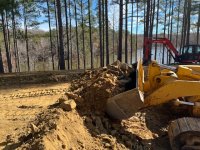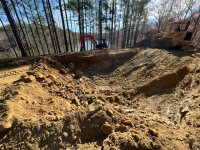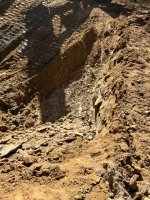Has anyone experienced pool bottom finishing in pretty rocky dig? I’m contracting out a grader (family friend who owns small grading company) and so far so good other than rock. Hit some in my shallow end that had to be hammered. Plan to get the rest roughed this weekend and wanted to start planning on how to shape the hopper if it’s rocky. My thoughts are having it dug by excavator as close as possible, finished by hand and probably a little overdug in areas with difficult rock. This will have to all be made up for and accommodated with vermiculite, that’s my current plan. Just wanted to see if any folks had to deal with this?
Pool Bottom Finishing
- Thread starter KermitThor
- Start date
You are using an out of date browser. It may not display this or other websites correctly.
You should upgrade or use an alternative browser.
You should upgrade or use an alternative browser.
Wanted to update that my deep end is also a rocky delight. I talked with my grader and we both agree the only way to get any sort of slope in the hopper is to excavate below dig depth and then backfill and re-dig. Not a huge deal but we are currently tossing around the idea of using clean dirt and just compacting in lifts with a jumping jack. Can anyone provide any insight into this? I'm sure there are better options (like screenings or crush and run) but I think properly compacted soiled with a total of like 8-12' of depth on bottom and walls both of which will have vermiculite finish applied really shouldn't be an issue of settling. I'm hoping someone can chime in with some experience here.
- Aug 20, 2020
- 5,819
- Pool Size
- 27000
- Surface
- Plaster
- Chlorine
- Salt Water Generator
- SWG Type
- CircuPool RJ-60
I don’t have any direct experience, but I have some council. Depending on the size of your pool, remember that water is heavy and normal methods of compacting soil are not necessarily applicable when placed under multiple tons of water.Wanted to update that my deep end is also a rocky delight. I talked with my grader and we both agree the only way to get any sort of slope in the hopper is to excavate below dig depth and then backfill and re-dig. Not a huge deal but we are currently tossing around the idea of using clean dirt and just compacting in lifts with a jumping jack. Can anyone provide any insight into this? I'm sure there are better options (like screenings or crush and run) but I think properly compacted soiled with a total of like 8-12' of depth on bottom and walls both of which will have vermiculite finish applied really shouldn't be an issue of settling. I'm hoping someone can chime in with some experience here.
Even minor settling in a concrete pool can cause a crack and the resulting leak can be a huge problem with water infiltration into the surrounding soil. Check out my pool deck rebuild thread for reference. My plaster has a crack running across it now and is almost certainly caused by building the pool partially over fill dirt that got wet over time after a skimmer leak.
Don’t trust the jumping jack, use rock for any minor spots you have to backfill. If you’re building a liner pool, this advice may not be as applicable on the leak portion since the liner can shift and stretch a bit without cracking.
This is a liner pool so I’m hoping for exactly what you mention, a little stretch. It’s also sitting on bedrock under this compacted soil. Post excavation, the vermiculite bottom should be on about 6-8” of well packed, clay based soil. It may settle enough to crack concrete, I agree, not sure what to expect a liner. Thanks for the info.I don’t have any direct experience, but I have some council. Depending on the size of your pool, remember that water is heavy and normal methods of compacting soil are not necessarily applicable when placed under multiple tons of water.
Even minor settling in a concrete pool can cause a crack and the resulting leak can be a huge problem with water infiltration into the surrounding soil. Check out my pool deck rebuild thread for reference. My plaster has a crack running across it now and is almost certainly caused by building the pool partially over fill dirt that got wet over time after a skimmer leak.
Don’t trust the jumping jack, use rock for any minor spots you have to backfill. If you’re building a liner pool, this advice may not be as applicable on the leak portion since the liner can shift and stretch a bit without cracking.
Thanks! Seems to be helping!I like your idea. Maybe me bumping this up will get a few more eyes on it.
- Aug 20, 2020
- 5,819
- Pool Size
- 27000
- Surface
- Plaster
- Chlorine
- Salt Water Generator
- SWG Type
- CircuPool RJ-60
Just think ahead for what might happen if (when?) a leak does occur. Clay soaked soil can shift or wash away over a long period of time so be careful to not just plan for what happens if everything is perfect, cause eventually it won’t be.This is a liner pool so I’m hoping for exactly what you mention, a little stretch. It’s also sitting on bedrock under this compacted soil. Post excavation, the vermiculite bottom should be on about 6-8” of well packed, clay based soil. It may settle enough to crack concrete, I agree, not sure what to expect a liner. Thanks for the info.
Yea, I can see that possibility. I’m not sure what I can do other? Stone on the bottom is easy enough but how do to grade sheet rock walls (which is all you can get from this soil)… that’s the root of this headacheJust think ahead for what might happen if (when?) a leak does occur. Clay soaked soil can shift or wash away over a long period of time so be careful to not just plan for what happens if everything is perfect, cause eventually it won’t be.
Take and share a picture of what you are working with. I have some ideas but need to see what is what first. Close up and at a slight distance.
- Aug 20, 2020
- 5,819
- Pool Size
- 27000
- Surface
- Plaster
- Chlorine
- Salt Water Generator
- SWG Type
- CircuPool RJ-60
Ah, I see. Are the walls under the liner going to be some kind of steel or fiberglass? If this is really a DIY pool maybe I’m assuming things that I shouldn’t.Yea, I can see that possibility. I’m not sure what I can do other? Stone on the bottom is easy enough but how do to grade sheet rock walls (which is all you can get from this soil)… that’s the root of this headache
Lots of rain here today. We took a few hours yesterday and tested the fill in method I mentioned. It seemed like it went well, I will grab some pics once the rain stops and I can pull tarps off.Take and share a picture of what you are working with. I have some ideas but need to see what is what first. Close up and at a slight distance.
Yea, the steel walls will all be sitting on virgin soil so that’s a big plus. The question comes down to how much settling (of compacted soil in deep end only) should be expected for the vermiculite and liner in the deep end. At the end of the day, the dirt is all sitting rock and will only be a few feet thick at most (the bottom of slopes). Even if is settled a full inch I would imagine the liner could absorb that, not sure what the vermiculite can handle. Again, I think that’s a worst case but this is conjecture on my part.Ah, I see. Are the walls under the liner going to be some kind of steel or fiberglass? If this is really a DIY pool maybe I’m assuming things that I shouldn’t.
I would not use dirt for ANY fill. The settling issues can show up years later or right away....maybe even five-six years later......trouble that you don't need.
Clean #57 rock is what I would suggest. (the same base used on many, if not most concrete pours)
It stays in place and needs NO compaction. It is easily formed and leveled and makes an almost perfect base for the poolkrete floor.
Clean #57 rock is what I would suggest. (the same base used on many, if not most concrete pours)
It stays in place and needs NO compaction. It is easily formed and leveled and makes an almost perfect base for the poolkrete floor.
I’m not sure of any way that the walls would hold up. We are talking about sheer walls, that’s a little exaggerated but it’s basically a rock cliff from shelf to pool bottom. I would think crusher run would probably hold its shape in a dig out but 57 seems like it would not hold these steep hopper slopes at all?I would not use dirt for ANY fill. The settling issues can show up years later or right away....maybe even five-six years later......trouble that you don't need.
Clean #57 rock is what I would suggest. (the same base used on many, if not most concrete pours)
It stays in place and needs NO compaction. It is easily formed and leveled and makes an almost perfect base for the poolkrete floor.
Last edited by a moderator:
I have missed something in your dig. I thought it was going to be a flat fill. I will re-read what you are doing and post back.I would think crusher run would probably hold its shape in a dig out but 57 seems like it would not hold these steep hopper slopes at all?
Thanks. Right now the shallow end is all on good virgin ground. The hopper required digging through flakey, cleaving bedrock and we had to over dig to give us room for a fill and redig which seemed to be our only option. I have to figure out a way to get compacted, formable material all the way back to shelf heigh so we can dig the hopper and get the slopes. The amount of actual compacted material that will be left is small, we overdue the hopper by ~8” so by the time we dig to depth for vermiculite I expect about 4-5” in most places for compacted material to remain. The slopes may have a little more in some places. The thought right now is to back fill with compacted soil in 6” lifts, dig the depth a little deep and add #57 on the bottom and long slope. The side slopes will hopefully hold shape and the pool should help push there. The side slopes are the biggest question mark imo.I have missed something in your dig. I thought it was going to be a flat fill. I will re-read what you are doing and post back.
- Aug 20, 2020
- 5,819
- Pool Size
- 27000
- Surface
- Plaster
- Chlorine
- Salt Water Generator
- SWG Type
- CircuPool RJ-60
I think my confusion is your description of the walls being an issue. The walls are setup, backfilled usually with gravel, rock, etc. My only concern was the bottom of the pool. You want to backfill and compact the sides so your decking doesn’t sink over time, but don’t backfill anything under the bottom with dirt.Thanks. Right now the shallow end is all on good virgin ground. The hopper required digging through flakey, cleaving bedrock and we had to over dig to give us room for a fill and redig which seemed to be our only option. I have to figure out a way to get compacted, formable material all the way back to shelf heigh so we can dig the hopper and get the slopes. The amount of actual compacted material that will be left is small, we overdue the hopper by ~8” so by the time we dig to depth for vermiculite I expect about 4-5” in most places for compacted material to remain. The slopes may have a little more in some places. The thought right now is to back fill with compacted soil in 6” lifts, dig the depth a little deep and add #57 on the bottom and long slope. The side slopes will hopefully hold shape and the pool should help push there. The side slopes are the biggest question mark imo.
I think I’m confusing you. The concern and area in question is the hopper of the pool. For this installation, steel walls will sit on a virgin soil shelf which then defends into a deep end hopper that is (right now) jagged rock cliffs 4’8” deep at the max. It slopes from 3” to 8 feet at deepest. The whole question is what I can use to allow me to reshape this hopper.I think my confusion is your description of the walls being an issue. The walls are setup, backfilled usually with gravel, rock, etc. My only concern was the bottom of the pool. You want to backfill and compact the sides so your decking doesn’t sink over time, but don’t backfill anything under the bottom with dirt.
- Aug 20, 2020
- 5,819
- Pool Size
- 27000
- Surface
- Plaster
- Chlorine
- Salt Water Generator
- SWG Type
- CircuPool RJ-60
There’s the issue. What’s a hopper?I think I’m confusing you. The concern and area in question is the hopper of the pool. For this installation, steel walls will sit on a virgin soil shelf which then defends into a deep end hopper that is (right now) jagged rock cliffs 4’8” deep at the max. It slopes from 3” to 8 feet at deepest. The whole question is what I can use to allow me to reshape this hopper.
Thread Status
Hello , This thread has been inactive for over 60 days. New postings here are unlikely to be seen or responded to by other members. For better visibility, consider Starting A New Thread.




